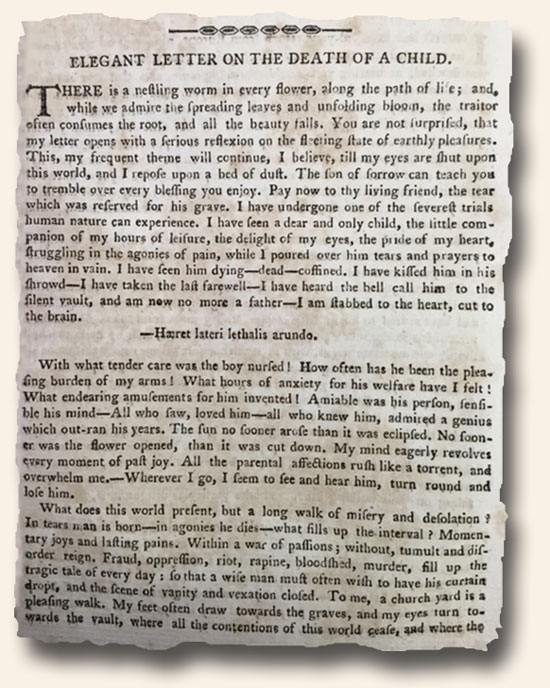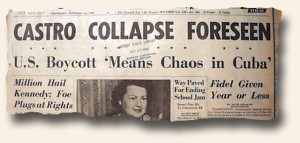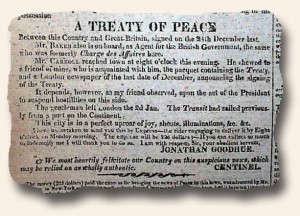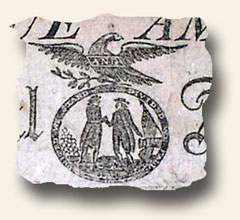A broken heart… 200+ years ago… today?
February 27, 2015 by GuyHeilenman · Leave a Comment
Anguish… deep sorrow… pain and emptiness that engulf and suffocate… As the saying goes: “The more things change, the more they stay the same.” No matter how far we advance as a race over time, the death of a loved one elicits the same paralyzing emotions today as it did 100… 1000… 5,000 years ago, and will continue to do so as long as humanity walks this earth. Such is the case (in spades) with a parent’s crushed spirit upon the loss of a child. While searching through an original printing of The American Magazine, Philadelphia, dated May, 1792 in the hopes of finding historical content, I came across the printing of a letter from a Father who was trying to come to terms with the untimely loss of his child. Language usage and expression aside, this letter written 200+ years ago could easily have been written yesterday. It also made me thankful for a hope beyond the grave – a hope that shouts from a Father’s pen as he attempts to express his heart… his love… his hope:
They put it in print… Castro given a year or less…
February 23, 2015 by TimHughes · Leave a Comment
 Historical perspective offers so much as we reflect upon some of the headlines of the past, particularly those proven to be so wrong. With the reestablishing of relations with Cuba currently in the headlines, we dug through out archives and found a headline which history has shown could not have been more wrong. The “Detroit Free Press” of October 20, 1960, in announcing the beginning of the embargo against Cuba, ran a banner headline: “CASTRO COLLAPSE FORESEEN” and one of the subheads noting: “Fidel Given Year or Less“. This is now a newspaper much more interesting today than it was almost 55 years ago.
Historical perspective offers so much as we reflect upon some of the headlines of the past, particularly those proven to be so wrong. With the reestablishing of relations with Cuba currently in the headlines, we dug through out archives and found a headline which history has shown could not have been more wrong. The “Detroit Free Press” of October 20, 1960, in announcing the beginning of the embargo against Cuba, ran a banner headline: “CASTRO COLLAPSE FORESEEN” and one of the subheads noting: “Fidel Given Year or Less“. This is now a newspaper much more interesting today than it was almost 55 years ago.
What a fascinating hobby!
Prices of newspapers… How have the changed?
February 20, 2015 by GuyHeilenman · 10 Comments
One of the questions we often receive at Rare Newspapers relates to the  collectible investment value of newspapers over time. Most indicate they do not collect for investment reasons; rather, they do so for the love of “History in your hands.” The embrace our motto: “History is never more fascinating than when it’s read from the day it was first reported.” Newspapers provide glimpses of history in the context of both the exciting and mundane of the era in which it was reported. Still, the question remains. How has the value of Rare & Early Newspapers progressed over time? We posed this question to our founder, Tim Hughes, and the following was his response:
collectible investment value of newspapers over time. Most indicate they do not collect for investment reasons; rather, they do so for the love of “History in your hands.” The embrace our motto: “History is never more fascinating than when it’s read from the day it was first reported.” Newspapers provide glimpses of history in the context of both the exciting and mundane of the era in which it was reported. Still, the question remains. How has the value of Rare & Early Newspapers progressed over time? We posed this question to our founder, Tim Hughes, and the following was his response:
We have to keep in mind that this hobby is a very small one, and when I began 39+ years ago there essentially was no established market, nor any sort of price guide which offered a baseline of values based on content, condition, etc.
I came from the coin collecting hobby and knew from it that the more rare the item, the more values increased through the years. Common date pennies were selling in the 1970’s for about the same prices as from a decade earlier, while the rare dates/coins had increased substantially. I took this information with me when I opted for a hobby which had yet to be exploited by an established collecting industry such as coins, stamps, books, etc. Although I purchased veraciously during my earlier years, always fearful the supply of 150+ year old newspapers would dry up, I have found that the common, generic material was always plentiful—and still is today. What has not been plentiful are newspapers with historic reports, and newspapers which are themselves very rare. The “less plentiful” issues have appreciated considerably over the last 39 years, while generic issue values are really not much different today than they were 39 years ago. Example: I always offered a 10-issue wholesale lot ever since my first catalog, then priced at $19.50. The same lot today is $24.95, and I suspect some of that increase is more to help offset increased shipping costs. And I think we have a virtually unending supply.
How much have values of historic & rare issues increased? It can be difficult to say as we have never made a point to keep comparative records as it seemed a bit meaningless for our purposes. But in general I would say they have increased 5-fold to 10-fold in the post 30 years. I’m not going to consider my first 9 years in the business as any sort of gauge as I was still feeling my way thru the hobby; raising & lowering prices as my customers would react (or not react). An anecdotal story: early on in my enterprise I purchased a bound volume of a Santa Fe, NM newspaper from 1881. Amongst the 150 or so issues was a run of, perhaps, 40 issues each having a little reward ad for the capture of Billy the Kid. Figuring a novice such as myself coming across the volume, and the fact that there were so many issues with the ad, I logically presume it was not very rare. I think I sold those issues for $35 or so each. If I would have those issues today I think we could get $700 each. That  doesn’t mean the value has increased by 2000%. It speaks more to my ignorance of what they should have sold for 35 years ago. Unfortunately that incident wasn’t my last such learning experience.
doesn’t mean the value has increased by 2000%. It speaks more to my ignorance of what they should have sold for 35 years ago. Unfortunately that incident wasn’t my last such learning experience.
Perhaps one of the more “common” of the very historic issues would be the Gentleman’s Mag. with the Declaration of Independence. We sold it for under $2000 ten years ago, and now we sell them for $4000. So this document in this title has doubled in 10 years, and I could never say that it is “rare” as we encounter this issue perhaps twice a year. It is extremely historic, but not truly rare. Truly rare items would have increased much more dramatically. In fact truly rare items don’t come on the market any more. I have few qualms offering a truly rare event/newspaper for 4 or 5 times our last price if we only had it twice in 39 years.
As is always the case–and as it truly should be in a free market economy–the collectors ultimately determine the prices of our material. There have always been high-income collectors who have kept the rare items rising in value at a consistent rate, while more common items have languished in value because collectors are not taking them off our shelves.
I cannot say that there has been any period over the last 39 years when the hobby was either “hot” or “cold”. I think whether values have rising nominally or dramatically, they have done so in a rather consistent curve, unaffected by the economy or stock market ups & downs.
I still believe the hobby is very much in its infancy. The vast majority of people have no idea that our hobby exists, and I have always felt the time will come when that will change. I don’t have to tell you that in a comparative sense with other collectables, our hobby seem dramatically undervalued.
Tim
People collect rare newspapers for various reasons – investment purposes being one of them. Finding hidden historical gems, preserving history, immersing oneself in an era and/or event, as a companion collectible to another collectible interest, etc. What a great hobby!
The Traveler… peace…
February 16, 2015 by The Traveler · 2 Comments
 Today I traveled to Boston by the means of the Columbian Centinel dated February 5, 1815. There I found the breaking news of the “A TREATY OF PEACE between this Country and Great Britain, signed on the 24th December last… I have undertaken to send you this by Express — the rider engaging to deliver it by Eight o’clock on Monday morning… I am with respect, Sir, your obedient servant, JONATHAN GOODHUE.”
Today I traveled to Boston by the means of the Columbian Centinel dated February 5, 1815. There I found the breaking news of the “A TREATY OF PEACE between this Country and Great Britain, signed on the 24th December last… I have undertaken to send you this by Express — the rider engaging to deliver it by Eight o’clock on Monday morning… I am with respect, Sir, your obedient servant, JONATHAN GOODHUE.”
This peace treaty ended the War of 1812 between the United States and Great Britain and Ireland. Due to lack of telecommunications and time travels at that time, even though the treaty was signed December 24, 1814, the Battle of New Orleans was fought and won on January 8, 1815 and the Treaty was not in effect until it was ratified by the U.S. Senate on February 18, 1815.
~The Traveler
They put it in print… First appearance of an American flag?
February 13, 2015 by TimHughes · Leave a Comment
Many in our hobby like to pursuit the very first time “they put it in print” and the “it” can be a very wide range of announcements, reports, or images. Certainly first reports of major 18th  and 19th century battles have been among the favored issues of collectors, and most certainly the first printing of ht Declaration of Independence in a newspaper commands a considerable premium among those who are able to consummate that pursuit.
and 19th century battles have been among the favored issues of collectors, and most certainly the first printing of ht Declaration of Independence in a newspaper commands a considerable premium among those who are able to consummate that pursuit.
Two collectors, Michael Zinman and Steve Lomazow, raised an interesting question: what newspaper was the first to include a print of the U.S. flag within its pages? After discovering several newspapers from 1847 and then 1840 with flag engravings, we found in our database the “True American & Commercial Advertiser” from Philadelphia, 1806 which incorporates a U.S. flag (albeit a small engraving: see photo) within the masthead image (see sample). The newspaper actually began in 1798 but that didn’t mean the masthead engraving was there. Typically mastheads change, often several times, through the life cycle of a newspaper.
But a confirmation from Vincent Golden, newspaper librarian at the American Antiquarian Society, which has holdings of this title going back to issue number 1, confirms the engraving with the flag is, indeed, present with that very first issue.
So this sets the earliest appearance of the U.S. flag in a newspaper at July 1, 1798. But I’m not convinced this is the earliest date. Are any of you collectors aware of an earlier appearance? Check your collections and share with the rest of us!
They put it in print… George Washington called a quack…
February 10, 2015 by TimHughes · Leave a Comment
Newspaper reports from the “other side” always provide some fascinating reading, such as Confederate vs. Yankee accounts of Civil War battles, or Allied vs. Nazi reports of World War II battles.
The same is true of the Revolutionary War. The “Pennsylvania Ledger” was a Loyalist newspaper and they spared little in criticizing the American, or “rebel”cause as they called it, for freedom. The January 21, 1778 issue has a fascinating letter which heavily criticizes Washington’s letter to Congress of October 5, 1777 (see below or go to this issue for full details). In the letter Washington puts an admittedly positive spin on his tragic loss at the battle of Germantown, which gives this writer a cause to respond.
He begins: “Mr. Washington’s letter to Congress…is perhaps the most extravagant piece of Jesuitical quackery that has been exhibited during the present rebellion. This heroic epistle abounds in deception, and incongruous contradiction in the extremely; it is calculated to mislead…”. His treatment of Washington doesn’t get any nicer. “This military quack…” is his next reference to the American leader, and he takes on one of the more famous quotes from Washington’s letter: ” ‘Upon the whole, it may be said the day was rather unfortunate than injurious.’ what a delicate and nice distinction here is held forth!…Who can help laughing at such an heterogeneous jumble of inconsistencies. Mr. Washington & his confederates have gained immortal honour by being suddenly put to flight by his Majesty’s troops…”.
Reading from the Loyalist side offers a perspective not to be found in newspapers supporting of the cause of Independence. What a fascinating hobby!
How Paul Revere’s Ride Was Published And Censored IN 1775…
February 6, 2015 by GuyHeilenman · Leave a Comment
 Todd Andrlik, founder and editor of Journal of the American Revolution, and curator, author and editor of Reporting the Revolutionary War: Before It Was History, It Was News (Sourcebooks, 2012), has assembled and written a great piece of scholarship in regards to Paul Revere – specifically, how he was viewed by his contemporaries, using the lens of original newspapers of his day. An excerpt is as follows:
Todd Andrlik, founder and editor of Journal of the American Revolution, and curator, author and editor of Reporting the Revolutionary War: Before It Was History, It Was News (Sourcebooks, 2012), has assembled and written a great piece of scholarship in regards to Paul Revere – specifically, how he was viewed by his contemporaries, using the lens of original newspapers of his day. An excerpt is as follows:
Because of Henry Wadsworth Longfellow’s famous poem, “Paul Revere’s Ride,” most people think that Revere was critical to the start of the Revolutionary War. In trying to dispel Longfellow’s myth of a lone hero, modern scholars have portrayed Revere as just one rider among dozens on 18-19 April 1775, and argued that his previous rides for the Patriot cause might have been more important. A survey of newspapers from 1774 and 1775 shows that in fact those earlier rides had made Revere prominent enough that he did stand out in reports of the fighting at Lexington and Concord, even as Massachusetts authorities kept the extent of his activities quiet.
Paul Revere was a man who wore many hats. He was well known throughout New England for his engravings, his silver work, his Masonic fellowship and his political activity. Plus, in 1774 and early 1775, Revere worked as an express rider for the Boston Committee of Correspondence and the Massachusetts Committee of Safety. He frequently carried letters, newspapers and other important communication between cities, including Boston, Hartford, New York and Philadelphia. Revere’s early dispatches related to some of the biggest American events of the eighteenth century, including the destruction of the tea, the Boston Port Bill and the Suffolk Resolves. In December 1774, at the age of 39, he rode to Portsmouth to alert local Patriot leaders that the Royal Navy was on its way to seize gunpowder and arms from Fort William and Mary. Newspaper printers would eagerly print Revere’s tidings, frequently attributing…
This is a must-read article! View Todd’s scholarship in its entirety at:
How Paul Revere’s Ride Was Published And Censored In 1775
The Traveler… the first admission… “black is beautiful” 1st coined…
February 2, 2015 by The Traveler · Leave a Comment
 Today I traveled to New York City by the means of two different titles… The New York Times of February 2, 1865 and the Harper’s Weekly of February 25, 1865. In the New York Times I found “J. S. Rock (Colored,) of the Supreme Court of Massachusetts, was to-day, on motion of Senator Sumner, admitted an Attorney and Counselor in the Supreme Court of the United States.”
Today I traveled to New York City by the means of two different titles… The New York Times of February 2, 1865 and the Harper’s Weekly of February 25, 1865. In the New York Times I found “J. S. Rock (Colored,) of the Supreme Court of Massachusetts, was to-day, on motion of Senator Sumner, admitted an Attorney and Counselor in the Supreme Court of the United States.”
The Harper’s Weekly includes a nice illustration of “John R. Rock, Colored Counselor”. Within the article reads “…Mr. Rock is known in Boston as a first-class lawyer. This even, following two days after the passage by Congress of the proposition to amend the Constitution so as to abolish slavery in the United States, will be regarded by the future historian as a remarkable indication of the revolution which is going on in the sentiment of a great people. Mr. Rock has never been a slave. He represents the colored freeman, as Mr. Douglass represents the freeman. This extraordinary reversal of the Dred Scott decision is an act almost sublime…”
In doing further research on Mr. Rock, he is also credited with coining the phrase “black is beautiful” while giving a speech in Boston in March of 1858 as a refutation of the western idea that the physical features of African Americans were unattractive. However, further research has found that he did not say those exact words but did in essence about the beauty of the black people.
~The Traveler



